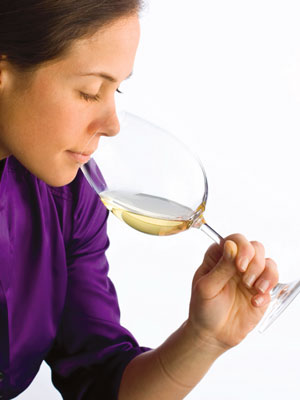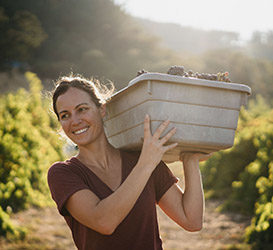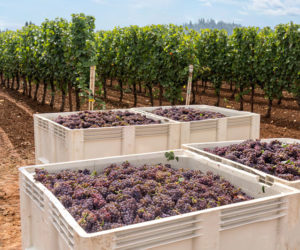
When it comes to white wine aromas, there are different paths to different destinations. As always, it all comes down to stylistic preferences. Do you want something tropical and bursting with aromas? Something subtle, mineral, and linear? Something buttery, rich, and oaky? Every destination has a different path, though of course there is some overlap — like protecting aromas by keeping vessels fully topped, for example. Let’s follow the grapes, from the vine to the bottle, and look at different ways you can guide your white wines to the destination of your choice.
Perhaps the most important choice, as well as the most obvious, is what grape(s) you choose. Chardonnay is not going to be as fruit-driven as Muscat or Viognier, and none of those will be capable of the herbaceous and thiol-y aromas (grapefruit, passion fruit, etc.) as a Sauvignon Blanc. All of these, however, can be guided in different directions, particularly with regard to where they’re grown (which is outside the scope of this article) and when they’re picked.
Generally speaking, earlier picked whites tend to be on the more floral, citric, and mineral/stone-y side (think 19–23 °Brix). Later picked whites tend toward tropical fruits and fruit complexities (24+ °Brix). Earlier will give you more acid and a leaner body, later more weight and fat. You can use this idea in two ways: Fine-tune what you’ve got or to make up for something you wish your grapes could deliver. As an example, if trying to coax as much mineral aroma out of a Chardonnay as possible, you’ll want to pick on the earlier side. But say you have Chardonnay in your backyard vineyard, but are always left feeling you want more fruit, you’ll want to pick it later.
Fermentation Control
Temperature is one of the most important ways to guide aromas during fermentation. Esters are the key word. Esters are aroma compounds that are primarily the product of fermentation itself (as opposed to originating in grapes). They are usually very fruity and very diverse; they can smell like pineapple, citrus, banana, floral, and much more. It’s important to note that some of these types of aromas can come from other compounds as well, though usually in a different “shade.” Citrus aromas, for example, are most associated with terpenes, so don’t assume that if you like citrus aromas, esters are necessarily what you want. Esters are also very fleeting: Most dissipate and cease to impact aroma 12–18 months after fermentation. So a good way to differentiate esters from other aroma types is to note the group that leaves the earliest. If you find yourself loving your wines very early on, and less so as some of that showy, ferment-y fruit goes away, you probably like esters.
Perhaps the most important choice, as well as the most obvious, is what grape(s) you choose.
To encourage ester retention, ferment cold (55–65 °F/13–18 °C). Although more esters are produced at higher temperatures, more are volatilized during warmer fermentation. Allow your ferment to get bubbling a little before lowering the temperature, as such cold temperatures are stressful for yeast. Then slowly lower the temperature to where you’d like. Maintain the cool temperature through the main part of fermentation, which is when yeast generate the most heat. As fermentation slows, take the temperature control off — yeast are struggling at this point (and generating less heat) and the cold temperatures can lead to stuck fermentation.
When fermenting cold yeast work slower, so your fermentation times can be three or more weeks. Another way to encourage esters is by having very clean must. Let your must settle really well to get as many solids out as possible — some even fine at this stage — before racking to the fermenter.
If you’re not into esters, ferment in a range around 68–70 °F (20–21 °C). This is warm enough that some esters will be blown off, but not warm enough to risk volatilizing much from the grapes. You’ll have a shorter fermentation and less chance of a stuck fermentation.
Glycol chillers can be expensive, but homebrewers have created enough of a demand for smaller units that they are now widely available with many options to choose from. I love the one I have and have used it for years. It can be purchased from Rapids Wholesale for under $1,000. It’s a 25-ft. Run Glycol Beer Chiller System, 1⁄6 HP. It’s powerful enough to chill 300-gallon (1,135-L) ferments or cold stabilize 75-gallon (284-L) drums. In a home setting it could be set up to chill multiple ferments at the same time, if connecting multiple snakes/plates with tubes. You can get cooling plates or snakes from an outlet like MoreWine.com — plates work better for ferments, as they have more surface area, but for small ferments, a snake should do. (For more on small-scale glycol systems, see “Home Glycol Cooling Systems” in the August-September 2020 issue or digital members can view it at winemakermag.com/article/home-glycol-cooling-systems).
Yeast, Enzymes, and Malolactic (ML)
Yeast is another way to guide aromatics. The main things to look for are higher or lower ester producers and beta-glucosidase producers, which unbind (release) more terpenes. There are many options, and other factors should be considered in yeast selection (such as temperature range and nutrient needs). There are various enzyme options to boost aromas (terpenes and thiols), such as alpha- and beta-glycosidase enzymes. These are used when you want to maximize aromatic intensity/fruitiness.
With spontaneous ferments, you never know what you’re going to get as far as the yeast’s propensity for ester production, beta-glucosidase production, and so on. I find that spontaneously fermented wines — when well cared for and clean — generally produce more intricate and complex wines, perhaps more non-fruit aromas, whereas those fermented with commercial yeast strains tend toward more aroma precision and clarity.
If using commercial malolactic (ML) bacteria, among other considerations (like pH), you can choose between high and low diacetyl producers. Diacetyl is the “buttery” aroma found in certain wines. You can also retain more diacetyl by inoculating for ML after primary has finished (yeast consume some diacetyl) and removing lees early in aging (which also diminish it). In contrast, you can minimize diacetyl by choosing a low producing strain, co-inoculating a few days into your primary fermentation, and retaining your lees during aging.
Aging
Vessel choice during aging can make a big aroma difference. Aging in glass or stainless generally keeps aromas more precise and “grape-based” versus oak. Neutral oak aging may soften or round aromas. Aging in newer oak or with oak adjuncts, of course, adds oak aromas. Aging in glass or stainless may encourage some reduction, which can frame wines nicely and add a bit of earthy/non-fruit complexity, as long as it isn’t too powerful. Temperature during aging is important as well, ideally keeping the wine below 65 to 70 °F (18 to 21 °C) at all times. Warmer periods may dull wines or encourage oxidation.
Fine lees can add a yeasty, bready complexity as well as more mouthfeel. To encourage these characteristics, age on the fine lees for a year or longer. It’s the guts of lees that cause the aromas and mouthfeel changes in wines, and it takes time for them to release. Champagne is a classic example of a wine in which this process in encouraged. Yeast slowly, but increasingly, leak out over the first year, and proper autolysis — when their membrane ruptures and a fuller release happens — occurs by the end of the first year. This can be sped up by more frequent lees stirring, or with specific enzymes.
Early in a wine’s aging, lees mostly serve as oxygen absorbers, adding little else. Stirring introduces oxygen to the wine, which if stirring small volumes frequently, can cause problems. If using carboys, you can gently angle the carboy to one side and roll on its base to whisk lees into suspension, thereby avoiding opening the carboy and introducing oxygen. Be extremely careful — carboys are delicate, their glass thick, and breaking one can lead to serious injury. This is best done slowly and gently on a soft surface, like carpet. Stirring is not always necessary, but I think it’s a good idea to do so every couple weeks early into aging to avoid lees compaction, which can cause bad reduction. After the first month or two you can probably leave them alone. Anecdotal evidence suggests that less (or no) stirring encourages an increase in the mouthfeel but not aromatic changes.
Always keep your vessels — whether they’re carboys, tanks, or barrels — full. Oxygen can lead to oxidation and encourage volatile acidity. I’ve said it in my column before, but oxidation is the #1 defect I’ve found when judging homemade wines. I suggest topping barrels every two weeks. Don’t allow for more than 1⁄8 of an inch (3 mm) of airspace in carboys. As temperatures drop in the winter, wine volume decreases, this means topping or adding sanitized marbles to carboys. This also means you may have some wine push through an airlock or pop a bung as temperatures increase in the spring, so keep a close eye on it and tend/clean accordingly: Better a small mess to clean than a damaged wine.
Racking
White wines don’t like oxygen like many reds do. Racking whites usually leads to a bit of aroma loss, albeit minimal if done gently. For the most part, it’s never advisable to splash rack whites. Submerge the “out” end of the hose you’re using into the wine in the receiving container. This gets more important the further into the aging process you get, as the wine becomes more susceptible to oxidation. The exception to this would be if you have a particularly reductive wine, or a wine which has held onto a lot of CO2 bubbles, in which case, an early splash rack may help get rid of reductive funk or dissipate CO2. As mentioned, I like a touch of reduction in my wines, and only splash if it’s off putting and very early . . . but this is an extreme case. I aim to treat the whites gently enough during aging that there is a tiny bit of CO2 left when I’m doing my last racking, prior to bottling. Dissolved CO2 helps protect the wine as it ages.
Minimize your wine’s rackings. Rack once off the gross lees a couple days after fermentation stops and again off the fine lees when you choose. When racking off the fine lees, rack into the vessel you’ll do any fining and cold stabilizing in (by doing these together, you avoid an unnecessary additional racking, and tartrates help compact the fined material, so you lose less wine). Finally, rack off the fined material and tartrates prior to bottling. That’s three rackings and bottling (a fourth racking). Keeping rackings to a minimum also adds a buffer in case there’s need for an emergency racking at some point, such as if copper sulfate treatment becomes necessary.
Sulfite Considerations
There are a lot of opinions out there with regard to how SO2 affects wine character. It’s en vogue these days to demonize SO2 for a multitude of reasons. I haven’t tasted enough (clean) no-SO2 wines to have a firm opinion on how SO2 affects wine aromatics, but based on what tasting I have done, and speaking with folks whose opinions I respect, skipping SO2 seems to lead to more vibrant, exuberant aromatics, while a wine after SO2 tends to be a bit more refined and subdued. It may come down to a matter of personal preference, and most likely depends on the individual wine and vintage. I had a Pinot Noir last year that I hated, but loved after SO2. I don’t think it’s a bad idea to minimize SO2 additions, but also don’t think it’s worth the great risk to not use it.
Fining and Filtration
Fining can make wines look prettier, but has a negative impact, though usually small, on aromatics. A low dose bentonite fining is unlikely to lead to any noticeable changes (bentonite is pretty gentle, benign stuff), but as with rackings, the little things add up. If looking to minimize the small damages processing does to a wine, skip fining agents, or keep it to a touch of bentonite. But know that a hazy wine will cost points if you plan on having it scored in a competition.
Filtration also strips wine of some aroma. The only reason I see to filter any table wine is if the wine has not gone through malolactic fermentation, or if you’re noticing an increase of volatile acidity and are concerned for microbial spoilage (Brett, lactic-acid bacterias, etc.). In these cases, you want to sterile filter or use lysozyme. I’m unaware of any research or anecdotal information of how much it might impact wine aroma.
So the major decisions for guiding your white wine’s aromatics comes in the vineyard and subsequently during fermentation and an optional ML fermentation — that’s the most dynamic time with the most options and choices. After that, it’s more a matter of protecting what you have as the wine makes its way to the bottle. White wines are more delicate than reds, so I think it best to treat them more gently.







